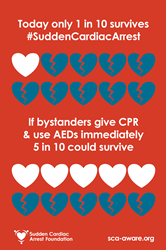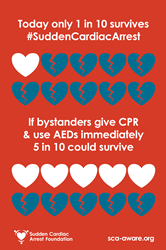
Survival depends largely on bystander intervention
Imagine the countless lives we could save if people understood the importance of Calling 911, starting CPR, and using an AED.
PITTSBURGH (PRWEB)
October 06, 2022
Each October, people add a little more pink to their lives as they bring awareness to those affected by breast cancer. With no disrespect to the color pink, the Sudden Cardiac Arrest Foundation is asking everyone to consider adding a little red too.
October is National Sudden Cardiac Arrest Awareness Month. Did you know that Sudden Cardiac Arrest (SCA) is a major public health crisis? It affects about 1,000 people outside hospital settings every day in the U.S. Sadly, survival to hospital discharge after EMS-treated out-of-hospital cardiac arrest (OHCA) is only about 10 percent.
One of the key challenges to reducing death and disability from OHCA is that survival largely depends on immediate action by people nearby who recognize the life-threatening emergency and decide to help. When bystanders provide hands-only CPR (cardiopulmonary resuscitation), survival rates triple to about 30 percent. When bystanders provide CPR, have access to, and use the nearest AED (automated external defibrillator), survival rates increase to about 50 percent.
When SCA occurs, the heart stops without warning. The person collapses and does not respond or breathe normally. They may gasp or shake as if having a seizure. SCA leads to death in minutes if the person doesn’t get help right away. Survival depends largely on the immediate action of people nearby who call 911, start CPR, and use an automated external defibrillator, or AED, when available.
Unfortunately, bystander action is limited. Only four in 10 victims receive bystander CPR and only one in 10 victims is treated with an AED before EMS arrives at the scene. Why don’t more people apply these fundamental lifesaving skills? Seven common myths may be barriers to understanding and action.
MYTH No. 1: SCA is rare. FACT: The number of people who die from SCA every day is equivalent to the number who would die if two jet planes crashed every day and killed nearly everyone on board.
MYTH No. 2: SCA is the same as a heart attack. FACT: When people have heart attacks, they are awake and their hearts are beating. When people have SCA, they are not awake and their hearts are not beating.
MYTH No. 3: SCA only happens to the elderly. FACT: SCA happens to people of all ages, including 23,000 youth each year.
MYTH No. 4: SCA only happens to people with a history of heart problems. FACTt: SCA is often the first indication of a heart problem.
MYTH No. 5: It is better to wait until professional help arrives. FACT: The victim’s outcome is often determined before EMS arrives.
MYTH No. 6: Only trained personnel are allowed to use AEDs. FACT: AEDs are lifesaving devices with visual and voice prompts that are designed for use by laypersons.
MYTH No. 7: AEDs can hurt people by shocking them inappropriately. FACT: AEDs are safe and effective and will not shock the heart unless shocks are needed to restore a healthy heartbeat.
“Bystander action in cases of Sudden Cardiac Arrest dramatically improves the likelihood of survival. With greater public awareness and understanding, thousands of lives could be saved every year,” said Mary M. Newman, MS, President of the Sudden Cardiac Arrest Foundation. “And, since 7 in 10 cardiac arrests occur in the home, taking time to learn CPR and how to use an AED could mean the difference between life and death for a loved one.”
Here’s what everyone needs to know. If you encounter someone in Sudden Cardiac Arrest, act quickly and decisively:
1. CALL: Call 911 and follow dispatcher instructions.
2. PUSH: Start CPR. Press hard and fast on the center of the chest at a rate of 100-120 beats per minute.
3. SHOCK: Use the nearest AED as quickly as possible.
“The Sudden Cardiac Arrest Foundation is committed to increasing awareness of Sudden Cardiac Arrest and the importance of immediate bystander action,” Newman added. “Imagine the countless lives we could save if people understood the importance of Calling 911, starting CPR, and using an AED.”
About Sudden Cardiac Arrest Foundation
Sudden Cardiac Arrest Foundation is a national community benefit 501(c)(3) organization. Our vision is to eliminate preventable death and disability from sudden cardiac arrest and support people affected by SCA. Our mission is to raise awareness of SCA and promote initiatives that help save lives through education, research, and community. Sudden Cardiac Arrest Foundation is a proud co-sponsor of the Call-Push-Shock movement. For more information, visit our website.
Share article on social media or email:

